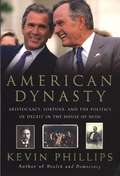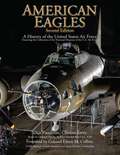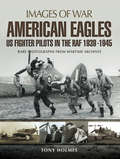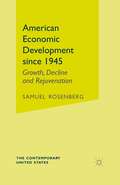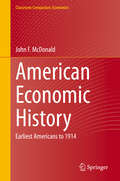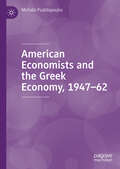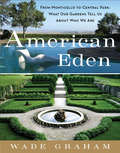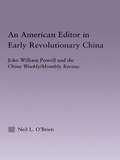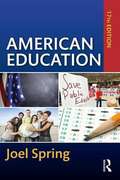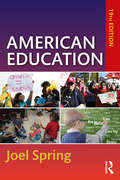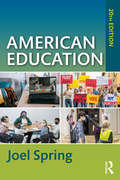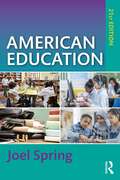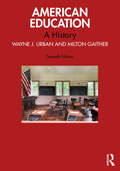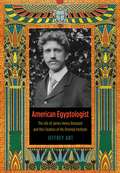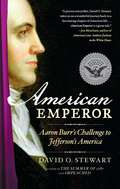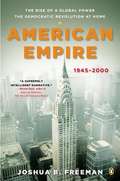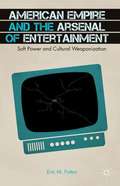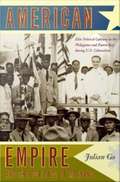- Table View
- List View
American Dynasty: Aristocracy, Fortune, and the Politics of Deceit in the House of Bush
by Kevin PhillipsThe Bushes are the family nobody really knows, says Kevin Phillips. This popular lack of acquaintance—nurtured by gauzy imagery of Maine summer cottages, gray-haired national grandmothers, July Fourth sparklers, and cowboy boots—has let national politics create a dynasticized presidency that would have horrified America’s founding fathers. They, after all, had led a revolution against a succession of royal Georges. In this devastating book, onetime Republican strategist Phillips reveals how four generations of Bushes have ascended the ladder of national power since World War One, becoming entrenched within the American establishment—Yale, Wall Street, the Senate, the CIA, the vice presidency, and the presidency—through a recurrent flair for old-boy networking, national security involvement, and political deception. By uncovering relationships and connecting facts with new clarity, Phillips comes to a stunning conclusion: The Bush family has systematically used its financial and social empire—its "aristocracy"—to gain the White House, thereby subverting the very core of American democracy. In their ambition, the Bushes ultimately reinvented themselves with brilliant timing, twisting and turning from silver spoon Yankees to born-again evangelical Texans. As America—and the world—holds its breath for the 2004 presidential election, American Dynasty explains how it happened and what it all means.
American Eagles: A History of the United States Air Force Featuring the Collection of the National Museum of the U.S. Air Force
by Dan Patterson Clinton TerryFeaturing the collection of airplanes, art, photographs, and memorabilia of the National Museum of the U.S. Air Force at Wright-Patterson Air Force Base near Dayton, Ohio, this magnificently illustrated book tells the story of the beginnings of flight, through the creation of the U.S. Air Force as a separate branch of the military, to the unbelievable technological achievements of what is the preeminent air power in the world today. Here are combat aces, Medal of Honor recipients, crusty generals, and average citizens who served in the Air Force. There are philosophers, airplane designers, test pilots, rocket scientists, armorers, and grease monkeys. More than 250 color and 150 black-and-white illustrations and photos and insightful text present the story of the U.S. Air Force of yesterday, today, and tomorrow, published on the occasion of the seventy-fifth anniversary of the United States Air Force and the one hundredth anniversary of the National Museum of the U.S. Air Force.
American Eagles: Rare Photographs From Wartime Archives (Images of War)
by Tony HolmesAmerican Eagles provides a photographic snapshot of the lives of the American fighter pilots who volunteered their services during World War II, as well as the Spitfires and Hurricanes they flew. Keen to help Britain stem the spread of Fascism, or perhaps seeking adventure in a foreign land, a number of American citizens defied the wishes of their government by crossing the border into Canada and subsequently sailing to Britain to join the Royal Air Force. Some were prewar civilian pilots, others were rich playboys and a few were already serving in the RAF when war was declared. Men such as Don Blakeslee, Billy Fiske, 'Gus' Daymond and Jim Dunn, as well as many other notable pilots are featured in this volume, in photographs that have been carefully sourced from official and private archives across the globe. Each image has a detailed caption, chronicling the wartime exploits of the elite 'band of brothers' known as the American Eagles.
American Eclipse: A Nation's Epic Race To Catch The Shadow Of The Moon And Win The Glory Of The World
by David BaronLonglisted for the PEN/E.O. Wilson Prize for Literary Science Writing Winner of the AIP Science Communication Award An Amazon Best Book of the Year (Science) A St. Louis Post-Dispatch Best Book of the Year Finalist for the Colorado Book Award (Nonfiction) Booklist Editors’ Choice (Science & Technology) Featuring a new afterword priming readers for the total solar eclipse of 2024, this “essential” (BBC) account brilliantly captures the celestial and human drama of eclipses. With this “suspenseful narrative history” (Maureen Corrigan, NPR’s Fresh Air), award-winning science writer David Baron tells the story of the enterprising scientists—among them, planet hunter James Craig Watson, pioneering astronomer Maria Mitchell, and ambitious young inventor Thomas Edison—who raced to Wyoming and Colorado in the summer of 1878, at the dawn of the Gilded Age, to observe the first great American eclipse. Thrillingly recreating the fierce jockeying of these nineteenth-century astronomers, Baron draws on years of “exhaustive research to reconstruct a remarkable chapter of U.S. history” (Lee Billings, Scientific American), when the fate of American science still hung precariously in the balance. Now updated with an afterword that unites eclipses and eclipse-chasers past and present—revisiting the total solar eclipse of 2017 and looking forward to that of 2024—American Eclipse reveals the enduring power of these ethereal events to bring people together across space and time.
American Economic Development since 1945: Growth, Decline and Rejuvenation (The Contemporary United States)
by S. RosenbergThis clearly-written book provides an historical analysis of postwar economic development in the United States, helping the reader to understand the nation's current economic position. Samuel Rosenberg investigates three postwar phases: the creation of an institutional framework setting the stage for prosperity in the U.S. after World War II; the forces undermining this institutional framework and the resulting stagflation of the 1970s; and the recreation of a new institutional structure in the 1980s. Basic economic concepts are introduced and explained throughout and specific attention is paid to macroeconomic policy, industrial relations, the role of the U.S. in the world economy, social and labour policy, the structure of the labour force, and the distribution of income by race and gender.
American Economic History
by Louis P. Cain Jonathan R. T. HughesIn simple, elegant language, Hughes and Cain walk students through four centuries of political, social, and economic history, with a focus on laws and institutions and an emphasis on current economic topics that reflects the latest scholarship. Rich in both quantitative techniques and economic theory, American Economic History demonstrates how an understanding of our past can illuminate economic issues that face society today and in the future.
American Economic History: Earliest Americans to 1914 (Classroom Companion: Economics)
by John F. McDonaldThis textbook introduces undergraduate and advanced undergraduate students to the economic foundations of America. Providing a rigorous yet accessible exploration of American Economic History from pre-Columbian times up to 1914, it explains the economic and demographic nuances of colonial America, including the Spanish, French, and English colonies and how they were governed. The book presents the details of the controversy between the English colonists and the English Parliament. It further features the impact of slavery, the Revolutionary and Civil War eras, and it includes extensive economic analysis of the post Civil War nation up to 1914. Based on the author's lectures, the book allows an easy understanding of the economic evolution from the earliest Americans to World War I. Instructors can customize their curriculum by supplementing this fundamental text with additional readings, offering flexibility while ensuring a solid knowledge of the economic aspects of American history.
American Economists and the Greek Economy, 1947-62
by Michalis PsalidopoulosThis book explores the role of American economists in Greece between 1947 and 1962. With a focus on economic thought and political relations, it examines the Greek economy following the Second World War and highlights the economic ideas and policies that brought Greece out of an economic depression. Collaboration between Greek, American, and British policymakers, economists, politicians, and administrators in providing humanitarian relief, economic rehabilitation and monetary order is highlighted. By examining the specific economic policies and how they were articulated, a nuanced view of policy making is presented that provides insight into policies that were shaped by both New Deal idealism and post-war realism. This book offers unique insights into the post-war reconstruction of Greece and the exchange of ideas between American and Greek economists. It will be of interest to students and researchers working within economic policy issues, international political economy and the history of economic thought.
American Eden: David Hosack, Botany, And Medicine In The Garden Of The Early Republic
by Victoria JohnsonThe untold story of Hamilton’s—and Burr’s—personal physician, whose dream to build America’s first botanical garden inspired the young Republic. <P><P>On a clear morning in July 1804, Alexander Hamilton stepped onto a boat at the edge of the Hudson River. He was bound for a New Jersey dueling ground to settle his bitter dispute with Aaron Burr. Hamilton took just two men with him: his “second” for the duel, and Dr. David Hosack. <P><P>As historian Victoria Johnson reveals in her groundbreaking biography, Hosack was one of the few points the duelists did agree on. Summoned that morning because of his role as the beloved Hamilton family doctor, he was also a close friend of Burr. A brilliant surgeon and a world-class botanist, Hosack—who until now has been lost in the fog of history—was a pioneering thinker who shaped a young nation. <P><P>Born in New York City, he was educated in Europe and returned to America inspired by his newfound knowledge. He assembled a plant collection so spectacular and diverse that it amazes botanists today, conducted some of the first pharmaceutical research in the United States, and introduced new surgeries to American. His tireless work championing public health and science earned him national fame and praise from the likes of Thomas Jefferson, James Madison, Alexander von Humboldt, and the Marquis de Lafayette. <P><P>One goal drove Hosack above all others: to build the Republic’s first botanical garden. Despite innumerable obstacles and near-constant resistance, Hosack triumphed when, by 1810, his Elgin Botanic Garden at last crowned twenty acres of Manhattan farmland. “Where others saw real estate and power, Hosack saw the landscape as a pharmacopoeia able to bring medicine into the modern age” (Eric W. Sanderson, author of Mannahatta). Today what remains of America’s first botanical garden lies in the heart of midtown, buried beneath Rockefeller Center. <P><P>Whether collecting specimens along the banks of the Hudson River, lecturing before a class of rapt medical students, or breaking the fever of a young Philip Hamilton, David Hosack was an American visionary who has been too long forgotten. Alongside other towering figures of the post-Revolutionary generation, he took the reins of a nation. In unearthing the dramatic story of his life, Johnson offers a lush depiction of the man who gave a new voice to the powers and perils of nature.
American Eden: From Monticello to Central Park to Our Backyards
by Wade GrahamThe story of our nation and ourselves as told through our country's most significant gardens and their creators. From Frederick Law Olmsted to Richard Neutra, Michelle Obama to our neighbors, Americans throughout history have revealed something of themselves--their personalities, desires, and beliefs--in the gardens they create. Rooted in the time and place of their making, as much as in the minds and identities of their makers, gardens mirror the struggles and energies of a changing society. Melding biography, history, and cultural commentary in a one-of-a-kind narrative, American Eden presents a dynamic, sweeping look at this country's landscapes and the visionaries behind them. Monticello's gardens helped Jefferson reconcile his conflicted feelings about slavery-and take his mind off his increasing debt. Edith Wharton's gardens made her feel more European and superior to her wealthy but insufficiently sophisticated countrymen. Martha Stewart's how-to instructions helped bring Americans back into their gardens, while at the same time stoking and exploiting our anxieties about social class. Isamu Noguchi's and Robert Smithson's experiments reinvigorated the age-old exchange between art and the garden. American Eden offers an inclusive definition of the garden, considering intentional landscapes that range from domestic kitchen gardens to city parks and national parks, suburban backyards and golf courses, public plazas and Manhattan's High Line park, reclaimed from freight train tracks. And it exposes the overlap between garden-making and painting, literature, and especially architecture-the garden's inseparable sibling-to reveal the deep interconnections between the arts and their most inspired practitioners. Moving deftly through time and place across America's diverse landscapes--from Revolutionary-era Virginia to turn-of-the-century Chicago to 1960s suburban California--and featuring a diverse cast of landscape-makers--whether artists, architects, or housewives, amateurs or professionals, robber barons, politicians, reformers, or dreamers--Wade Graham vividly unfolds the larger cultural history through more personal dramas. Beautifully illustrated with color and black-and-white images, American Eden is at once a different kind of garden book and a different kind of American history, one that offers a compelling, untold story--a saga that mirrors and illuminates our nation's invention, and constant reinvention, of itself.
American Editor in Early Revolutionary China: John William Powell and the China Weekly/Monthly Review
by Neil O'BrienThis is a study of Sino-American relations and the editorial policy of the China Weekly Review / China Monthly Review , published in Shanghai by John William Powell during the Chinese Civil War and the Korean War. The Review supported US attempts in early 1946 to avert civil war through the creation of a coalition government. By 1947 it reflected growing disillusionment with Guomindang policies, and increasing sympathy for the demands of impoverished students and faculty for multi-party democracy and peace. As the Civil War shifted in favour of the Communists in late 1948, Powell and the Review counseled US businessmen to remain in Shanghai and urged the US government to establish working relations with the Communists, and later to recognize the new regime. Staying in Shanghai to report changes engendered by the Communist victory, the Review 's staff accomodated themselves to the new orthodoxy and to the regime's coordination of the press. During the Korean War, the Review opposed the expanding US air war, becoming the foremost American purveyor of Chinese and North Korean allegations of American use of bacteriological weapons. The Review was also utilized for the political indoctrination of US prisoners-of-war by the Chinese and North Koreans. After closing the Review in July 1953 and returning to the United States, Powell, his wife Sylvia Campbell and assistant editor Julian Schuman were put on trial for sedition. As the government narrowed its focus to the bacteriological warfare issue, Powell and his lawyers countered by trying to prove the veracity of the charges, seeking witnesses in China and North Korea. Adverse publicity led to a mistrial in January 1959 and limitations in both the sedition and treason statutes ended plans to renew prosecution. Powell and the Review had insisted that positive diplomatic and economic relations between China and the United States were both possible and desirable. The gradual normalization of trade, investment and political relations since the 1970s seemed to validate this belief. In the post-Cold War age when Sino-American relations are often strained and tempestuous, this book serves as a reminder of the value of making the extra effort to achiece understanding.
American Education
by Wayne J. Urban Jennings L. Wagoner Jr.American Education: A History, 5e is a comprehensive, highly-regarded history of American education from pre-colonial times to the present. Chronologically organized, it provides an objective overview of each major period in the development of American education, setting the discussion against the broader backdrop of national and world events. The first text to explore Native American traditions (including education) prior to colonization, it also offers strong, ongoing coverage of minorities and women. This edition includes more visual illustrations as well as new or expanded attention to the Jacksonian era and the politics surrounding the Common School, the McGuffey Readers, church-school-immigrant conflicts and accommodations, the Morrill Acts, community colleges, youth organizations, the impact of the Great Depression and the Dust Bowl years, education and the Civilian Conservation Corps, National Youth Administration, and the No Child Left Behind (NCLB) and Race to the Top (RttT) legislation. Also, a new epilogue provides closing comments on the present and future prospects for American education. Balanced Perspective - The authors provide contrasting views of American educational traditions, reforms, and theories in order to maintain a balanced view of events. They also set discussions against the broader backdrop of national and world events. Pre-colonial Focus - A unique and much praised opening chapter discusses the educational traditions of Native Americans and the two-way learning exchanges that occurred between two distinct "old world" cultures, that is, between Native American and European cultures. The Indians taught as well as learned from the colonists. No other text has this feature. Cultural Conflict Focus - Throughout the text attention is paid to the cultural conflicts embedded in the majority-minority struggles of Native Americans and various immigrant groups throughout the nation's history. Chapter 5, Class, Caste and Education in the South, concentrates on the subjugation of African Americans and the use of education to both facilitate and fight that subjugation. Readability - Reviewers have labelled this the "best written text on the market" in terms of style, clarity and interest. "It's clarity and readability differentiate it from other books."
American Education
by Joel SpringJoel Spring's American Education introduces readers to the historical, political, social, and legal foundations of education and to the profession of teaching in the United States. In his signature straightforward and concise approach to describing complex issues, Spring illuminates events and topics and that are often overlooked or whitewashed, giving students the opportunity to engage in critical thinking about education. In this edition he looks closely at the global context of education in the U.S. Featuring current information and challenging perspectives--with scholarship that is often cited as a primary source, students will come away from this clear, authoritative text informed on the latest topics, issues, and data and with a strong knowledge of the forces shaping of the American educational system. Changes in the 17th Edition include new and updated material and statistics on economic theories related to "skills" education and employability the conflict between a skills approach and cultural diversity political differences regarding education among the Republican, Democratic, Libertarian and Green parties social mobility and equality of opportunity as related to schooling global migration and student diversity in US schools charter schools and home schooling
American Education (Sociocultural, Political, and Historical Studies in Education)
by Joel SpringFeaturing current information and challenging perspectives on the latest issues and forces shaping the American educational system—with scholarship that is often cited as a primary source—Joel Spring introduces readers to the historical, political, social, and legal foundations of education and to the profession of teaching in the United States. In his signature straightforward, concise approach to describing complex issues, he illuminates events and topics that are often overlooked or whitewashed, giving students the opportunity to engage in critical thinking about education. Students come away informed on the latest topics, issues, and data and with a strong knowledge of the forces shaping the American educational system. Thoroughly updated throughout, the new edition of this clear, authoritative text remains fresh and up-to-date, reflecting the many changes in education that have occurred since the publication of the previous edition. Topics and issues addressed and analyzed include: • The decline of the Common Core State Standards, particularly as result of a Republican-controlled administration currently in place• Increasing emphasis on for-profit education, vouchers, charter schools, and free-market competition between schools, expected to surge with the appointment of the new U.S. Secretary of Education Betsy DeVos • Current debates about immigration and "Dreamers"—new statistics on immigrant education, discussion of education proposals to accommodate the languages, cultures, and religions of newly arrived immigrants• New education statistics on school enrollments, dropouts, education and income, school segregation, charter schools, and home languages• The purposes of education as presented in the 2016 platforms of the Republican, Democratic, Green, and Libertarian parties• Discussions around transgender students
American Education (Sociocultural, Political, and Historical Studies in Education)
by Joel SpringFeaturing current information and challenging perspectives on the latest issues and forces shaping the American educational system—with scholarship that is often cited as a primary source—Joel Spring introduces readers to the historical, political, social and legal foundations of education and to the profession of teaching in the United States. In his signature straightforward, concise approach to describing complex issues, he illuminates events and topics that are often overlooked or whitewashed, giving students the opportunity to engage in critical thinking about education. Students come away informed on the latest topics, issues and data and with a strong knowledge of the forces shaping the American educational system. Thoroughly updated throughout, the 20th edition of this clear, authoritative text remains fresh and up to date, reflecting the many changes in education that have occurred since the publication of the previous edition, such as: The effects of the pandemic on schools, teachers, students, learning and social goals The latest U.S. Department of Education guidelines for school prayer, regulations on sexual harassment and Title IX and guidelines for writing IEPs Expanded discussion of institutional racism Coverage relating to transgender youth and athletics
American Education (Sociocultural, Political, and Historical Studies in Education)
by Joel SpringFeaturing current information and challenging perspectives on the latest issues and forces shaping the American educational system—with scholarship that is often cited as a primary source—Joel Spring introduces readers to the historical, political, social and legal foundations of education and to the profession of teaching in the United States. In his signature straightforward, concise approach to describing complex issues, he illuminates events and topics that are often overlooked or whitewashed, giving students the opportunity to engage in critical thinking about education. Students come away informed on the latest topics, issues and data and with a strong knowledge of the forces shaping the American educational system. Updated throughout, the 21st edition of this clear, authoritative text remains fresh and up-to-date, reflecting the many changes in education that have occurred since the publication of the previous edition. New coverage includes: Discussion of “culture wars” and critical race theory Parental rights versus the goals of common education LGBTQIA+ students’ rights Discussion of the current administration’s educational policies
American Education: A History
by Wayne J. Urban Milton GaitherAmerican Education: A History, Seventh Edition is a comprehensive, highly regarded history of American education from precolonial times to the present.Chronologically organized, the new edition provides an objective overview of each major period in the development of American education, setting the discussion against the broader background of national and world events. In addition to its in-depth exploration of Native American traditions (including education) prior to colonization, it also offers strong, ongoing coverage of minorities and women. Features for the seventh edition include: Every chapter extensively revised to incorporate the most recent historical scholarship, to increase readability, and to make the content relevant for today’s educators. Chapter overviews and end-of-chapter reflection questions to aid comprehension and discussion. Updated and expanded coverage of Native American education, the role of women progressives in schools, rural schooling, public education, minority populations, and much more. Brand new topics, such as education policy under Trump and Biden, the impact of the COVID-19 pandemic on schools, student mental health, critical race theory, culturally responsive education, and textbook censorship. This much-anticipated seventh edition is essential reading for undergraduate and graduate History of Education courses.
American Education: A History (Patterson's American Education Ser.)
by Wayne Milton Gaither Jennings J. Urban L. WagonerThis is a lively account of one of the most important and overlooked themes in American education. Beginning in the colonial period and working to the present, Gaither describes in rich detail how the home has been used as the base for education of all kinds. The last five chapters focus especially on the modern homeschooling movement and offer the most comprehensive and authoritative account of it ever written. Readers will learn how and why homeschooling emerged when it did, where it has been, and where it may be going.
American Education: From The Puritans To The Trump Era (Sociocultural, Political, and Historical Studies in Education)
by Joel SpringFeaturing current information and challenging perspectives on the latest issues and forces shaping the American educational system—with scholarship that is often cited as a primary source, Joel Spring introduces readers to the historical, political, social, and legal foundations of education and to the profession of teaching in the United States. In his signature straightforward, concise approach to describing complex issues, he illuminates events and topics that are often overlooked or whitewashed, giving students the opportunity to engage in critical thinking about education. Students come away informed on the latest topics, issues, and data and with a strong knowledge of the forces shaping the American educational system. Thoroughly updated throughout, the 18th edition of this clear, authoritative text remains fresh and up to date, reflecting the many changes in education that have occurred since the publication of the previous edition. Topics and issues addressed and analyzed include • The decline of the Common Core State Standards, particularly as result of a Republican-controlled administration currently in place • Increasing emphasis on for-profit education, vouchers, charter schools and free-market competition between schools, expected to surge with the appointment of the new U.S. Secretary of Education Betsy DeVos • Current debates about immigration and "Dreamers"—new statistics on immigrant education, discussion of education proposals to accommodate the languages, cultures and religions of newly arrived immigrants • New education statistics on school enrollments, dropouts, education and income, school segregation, charter schools and home languages • The purposes of education as presented in the 2016 platforms of the Republican, Democratic, Green, and Libertarian parties • Discussions around transgender students
American Egyptologist: The Life of James Henry Breasted and the Creation of His Oriental Institute
by Jeffrey AbtJames Henry Breasted (1865-1935) had a career that epitomizes our popular image of the archaeologist. Daring, handsome, and charismatic, he traveled on expeditions to remote and politically unstable corners of the Middle East, helped identify the tomb of King Tut, and was on the cover of Time magazine. But Breasted was more than an Indiana Jones--he was also an accomplished scholar, academic entrepreneur, and talented author who brought ancient history to life not just for students but for such notables as Teddy Roosevelt and Sigmund Freud. In American Egyptologist, Jeffrey Abt weaves together the disparate strands of Breasted's life, from his small-town origins following the Civil War to his evolution into the father of American Egyptology and the founder of the Oriental Institute in the early years of the University of Chicago. Abt explores the scholarly, philanthropic, diplomatic, and religious contexts of his ideas and projects, providing insight into the origins of America's most prominent center for Near Eastern archaeology. An illuminating portrait of the nearly forgotten man who demystified ancient Egypt for the general public, American Egyptologist restores James Henry Breasted to the world and puts forward a brilliant case for his place as one of the most important scholars of modern times.
American Egyptologist: The Life of James Henry Breasted and the Creation of His Oriental Institute
by Jeffrey AbtJames Henry Breasted (1865–1935) had a career that epitomizes our popular image of the archaeologist. Daring, handsome, and charismatic, he traveled on expeditions to remote and politically unstable corners of the Middle East, helped identify the tomb of King Tut, and was on the cover of Time magazine. But Breasted was more than an Indiana Jones—he was an accomplished scholar, academic entrepreneur, and talented author who brought ancient history to life not just for students but for such notables as Teddy Roosevelt and Sigmund Freud.In American Egyptologist, Jeffrey Abt weaves together the disparate strands of Breasted’s life, from his small-town origins following the Civil War to his evolution into the father of American Egyptology and the founder of the Oriental Institute in the early years of the University of Chicago. Abt explores the scholarly, philanthropic, diplomatic, and religious contexts of his ideas and projects, providing insight into the origins of America’s most prominent center for Near Eastern archaeology. An illuminating portrait of the nearly forgotten man who demystified ancient Egypt for the general public, American Egyptologist restores James Henry Breasted to the world and puts forward a brilliant case for his place as one of the most important scholars of modern times.
American Emperor: Aaron Burr's Challenge to Jefferson's America
by David O. StewartIn this vivid and brilliant biography, David Stewart describes Aaron Burr, the third vice president, as a daring and perhaps deluded figure who shook the nation’s foundations in its earliest, most vulnerable decades. In 1805, the United States was not twenty years old, an unformed infant. The government consisted of a few hundred people. The immense frontier swallowed up a tiny army of 3,300 soldiers. Following the Louisiana Purchase, no one even knew where the nation’s western border lay. Secessionist sentiment flared in New England and beyond the Appalachians. Burr had challenged Jefferson, his own running mate, in the presidential election of 1800. Indicted for murder in the dueling death of Alexander Hamilton in 1804, he dreamt huge dreams. He imagined an insurrection in New Orleans, a private invasion of Spanish Mexico and Florida, and a great empire rising on the Gulf of Mexico, which would swell when America’s western lands seceded from the Union. For two years, Burr pursued this audacious dream, enlisting support from the General-in-Chief of the Army, a paid agent of the Spanish king, and from other western leaders, including Andrew Jackson. When the army chief double-crossed Burr, Jefferson finally roused himself and ordered Burr prosecuted for treason. The trial featured the nation’s finest lawyers before the greatest judge in our history, Chief Justice John Marshall, Jefferson’s distant cousin and determined adversary. It became a contest over the nation’s identity: Should individual rights be sacrificed to punish a political apostate who challenged the nation’s very existence? In a revealing reversal of political philosophies, Jefferson championed government power over individual rights, while Marshall shielded the nation’s most notorious defendant. By concealing evidence, appealing to the rule of law, and exploiting the weaknesses of the government’s case, Burr won his freedom. Afterwards Burr left for Europe to pursue an equally outrageous scheme to liberate Spain’s American colonies, but finding no European sponsor, he returned to America and lived to an unrepentant old age. Stewart’s vivid account of Burr’s tumultuous life offers a rare and eye-opening description of the brand-new nation struggling to define itself.
American Empire
by Eric Foner Joshua FreemanA landmark history of postwar America and the second volume in the Penguin History of the United States series In this momentous work, acclaimed labor historian Joshua B. Freeman presents an epic portrait of the United States in the latter half of the twentieth century, revealing a nation galvanized by change even as conflict seethed within its borders. Beginning in 1945, he charts the astounding rise of the labor movement and its pitched struggle with the bastions of American capitalism in the 1940s and '50s, untangling the complicated threads between the workers' agenda and that of the civil rights and women's movements. Through the lens of civil rights, the Cold War struggle, and the labor movement, American Empire teaches us something profound about our past while illuminating the issues that continue to animate American political discourse today. world.
American Empire and the Arsenal of Entertainment
by Eric M. FattorMovies, television, and American culture permeates even the most remote reaches of the globe in unprecedented levels. What affect does the spread of the American zeitgeist have on global perceptions of the US? This book analyzes the complex role entertainment plays in foreign policy - weighing its benefits and setbacks to national interests abroad.
American Empire and the Politics of Meaning: Elite Political Culture in the Philippines and Puerto Rico During U.S. Colonialism
by Julian GoWhen the United States took control of the Philippines and Puerto Rico in the wake of the Spanish-American War, it declared that it would transform its new colonies through lessons in self-government and the ways of American-style democracy. In both territories, U. S. colonial officials built extensive public school systems, and they set up American-style elections and governmental institutions. The officials aimed their lessons in democratic government at the political elite: the relatively small class of the wealthy, educated, and politically powerful within each colony. While they retained ultimate control for themselves, the Americans let the elite vote, hold local office, and formulate legislation in national assemblies. American Empire and the Politics of Meaning is an examination of how these efforts to provide the elite of Puerto Rico and the Philippines a practical education in self-government played out on the ground in the early years of American colonial rule, from 1898 until 1912. It is the first systematic comparative analysis of these early exercises in American imperial power. The sociologist Julian Go unravels how American authorities used "culture" as both a tool and a target of rule, and how the Puerto Rican and Philippine elite received, creatively engaged, and sometimes silently subverted the Americans' ostensibly benign intentions. Rather than finding that the attempt to transplant American-style democracy led to incommensurable "culture clashes," Go assesses complex processes of cultural accommodation and transformation. By combining rich historical detail with broader theories of meaning, culture, and colonialism, he provides an innovative study of the hidden intersections of political power and cultural meaning-making in America's earliest overseas empire.
